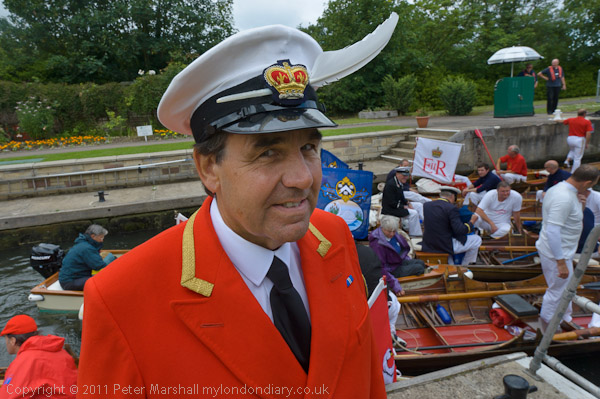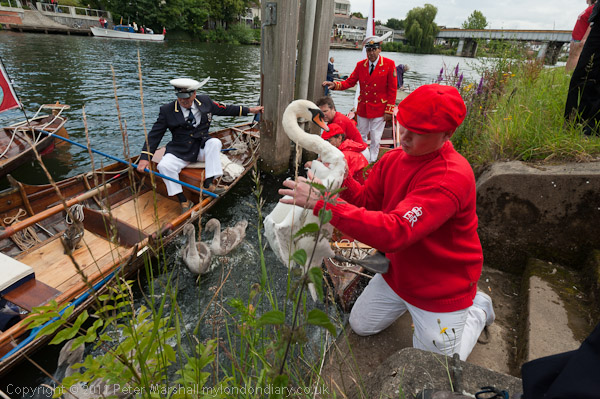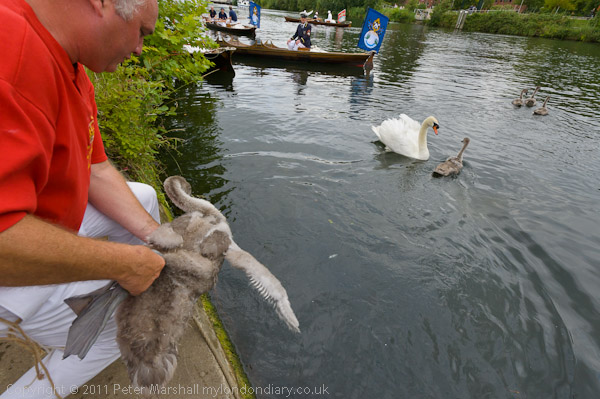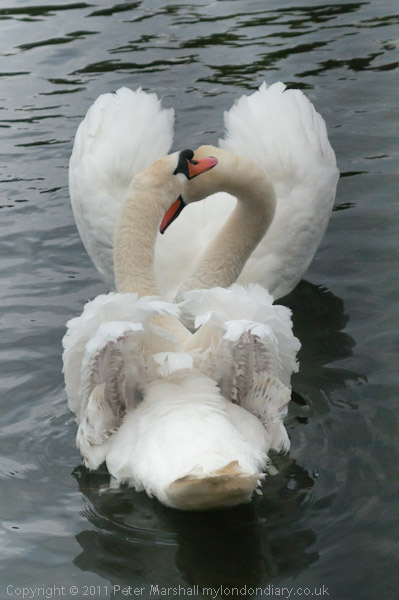One day a year I allow myself to photograph swans.
“Photography is not cute cats, nor nudes, motherhood or arrangements of manufactured products. Under no circumstances it is anything ever anywhere near a beach. Walker Evans“
Had Evans lived in the UK, I’m sure swans would have featured in his list of no-nos (even if, for the moment I can’t remember an Edward Weston picture featuring one.) Back in the years when I used sometimes to have to look at photography displays in schools my heart would sink when I saw a wall heavily laden with these birds. Another staple, cemeteries and gravestones, was somehow far less dispiriting.
But once a year I give myself special licence and go out and shoot the Queen’s birds (and those she graciously allows to the Dyers and Vintners.) Not literally shoot them of course, it’s probably still a hanging offence and even they don’t shoot them any more. They don’t even eat them or even make nicks in their beaks to mark them. Upping is now more a kind of roving clinic that gives the cygnets a quick MOT and snaps a ring around a leg so they can be identified in later years.
I’m not in favour of royal privilege, and find it ridiculous that the Queen or anyone else should claim rights on these wild birds, but there are some positive aspects to the upping as it is today, both for the health of the birds and also as a more general measure of the health of the environment. On our stretch of the river, despite apparent increases in water quality and banning anglers using lead weights (the latter prompted in part by evidence from the upping) swans are not doing well. They swarm on the river in great herds, but don’t breed, or certainly very much less than they used to only a few years ago.
I’ve photographed the uppers most years since I stopped teaching on Mondays – the day they come more or less past where I live – in 1999. It’s not as good as it used to be, partly because we have less breeding swans now, but also because they no longer have a man on a bike going ahead of the crews and attracting the swan families to handy spots by feeding them biscuits. I got to know Eric who did this, and for a few years rode along with him and could occasionally give him the benefit of a little local knowledge. He was a great help as he almost always managed to get the swans to a good place to photograph on the same side of the river as the towpath – and his and my bicycle. Now the Swan Warden’s outboard dinghy goes ahead, but not very far ahead, and the swans are upped wherever they happen to be.
I wasn’t going to bother with the swans this year, as I’ve got to the point where I have good pictures of almost everything, enough for a decent book, and really the only thing that would add to it would be some pictures from further up the river. One year when I’m less busy I’ll ask to go on the official press boat again and follow it further, as further upstream a bicycle becomes less useful. Though I may need to borrow a long lens to make it really worthwhile.

But it turned out to be a nice day, and I thought I could spare a couple of hours in the morning, so I decided to go after all. By the time I’d followed it for a couple of hours and the only cygnets that had been found were up a backwater and on the opposite bank where even after I’d waded through chest high stinging nettles I could only get the poorest of views, I was thinking I should have stayed at home.

Finally they came across a swan with six cygnets just a hundred yards or so short of their lunchtime stop at the Swan Inn in Staines, and there was a decent opportunity to see them at work. Unfortunately the bank where they boats surrounded the swans was a little overgrown, and there wasn’t time to do some gardening, so what would have been the best pictures are seen through rather too many weeds in the foreground, but I made a few that were not too bad. There are just a few parts of the event that are difficult – and usually impossible – to photograph well, for example when the birds are being returned to the water, as you would need to be in the river and in the way to be in the right place.

The upppers didn’t catch the male swan, who had been on the other side of the river, and he swum around a few yards away watching while his mate and offspring were being processed on the bank. There was a touching scene when the female swan was put back into the water and swam out to meet him, and despite my feelings about pictures of swans I had to take some pictures.
I grabbed the D300 which had the Sigma 28-300 attached and took a series of pictures without stopping to check exposure – having previously been using it I knew they wouldn’t be far out.
When I looked at the images after the swans had moved apart, I found that they were all very dark towards one edge. Eventually I worked out that the camera wasn’t working properly at speeds faster than around 1/1500 s. Testing showed the image darkened and blacked out from one edge progressively at speeds above this, unitl the entire image had gone at 1/4000 s, even wide open where it should have been fully exposed.

Fortunately Lightroom with its graduated filter came to my rescue (though I still find it very tricky to use) and the defect it fairly hard to spot in the final result.
It isn’t a fault that will worry me in normal use, where I seldom use fast shutter speeds, and the camera is long out of warranty, so I’ve decided to live with the problem until something really important goes wrong. Perhaps before that happens Nikon will announce a new model that I’ll want to get rather than repairing the D300.
See more pictures (and text) at Swan Upping on My London Diary